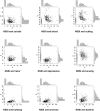A Google Trends-based approach for monitoring NSSI - PubMed (original) (raw)
A Google Trends-based approach for monitoring NSSI
Nicola Luigi Bragazzi. Psychol Res Behav Manag. 2013.
Abstract
Non-suicidal self-injury (NSSI) is an intentional, direct, and socially unacceptable behavior resulting in the destruction of one's own body tissues with no intention of dying or committing suicide, even though it is associated with a higher risk of attempted, planned, or just considered suicide. In this preliminary report, we introduce the concept of "NSSI 2.0"; that is to say, the study of the Internet usage by subjects with NSSI, and we introduce a Google Trends-based approach for monitoring NSSI, called NSSI infodemiology and infoveillance. Despite some limitations, Google Trends has already proven to be reliable for infectious diseases monitoring, and here we extend its application and potentiality in the field of suicidology. Ad hoc web portals and surveys could be designed in light of the reported results for helping people with NSSI.
Keywords: Internet; infodemiology; infoveillance; non-suicidal self-injury.
Figures
Figure 1
Google Trends-based NSSI hit-search volume over the years (from 2004 to 2012). Notes: NSSI hit-search volume over the years 2004–2012 (top), a map of Italian towns with higher flux volumes (bottom, left), and a list of the most searched NSSI-related terms (bottom, right). Abbreviation: NSSI, non-suicidal self-injury.
Figure 2
Autocorrelation plot for the NSSI hit-search and partial autocorrelation plot, showing a regular cyclical pattern. Abbreviations: ACF, autocorrelation function; NSSI, non-suicidal self-injury; PACF, Partial autocorrelation function.
Figure 3
Pearson’s correlation plots for some of the most important NSSI-related hit search terms. Abbreviation: NSSI, non-suicidal self-injury.
Similar articles
- Infodemiology and infoveillance of multiple sclerosis in Italy.
Bragazzi NL. Bragazzi NL. Mult Scler Int. 2013;2013:924029. doi: 10.1155/2013/924029. Epub 2013 Aug 20. Mult Scler Int. 2013. PMID: 24027636 Free PMC article. - Googling Self-injury: the state of health information obtained through online searches for self-injury.
Lewis SP, Mahdy JC, Michal NJ, Arbuthnott AE. Lewis SP, et al. JAMA Pediatr. 2014 May;168(5):443-9. doi: 10.1001/jamapediatrics.2014.187. JAMA Pediatr. 2014. PMID: 24663445 - Examining the link between nonsuicidal self-injury and suicidal behavior: a review of the literature and an integrated model.
Hamza CA, Stewart SL, Willoughby T. Hamza CA, et al. Clin Psychol Rev. 2012 Aug;32(6):482-95. doi: 10.1016/j.cpr.2012.05.003. Epub 2012 May 11. Clin Psychol Rev. 2012. PMID: 22717336 Review. - Non-suicidal self-injury, suicide ideation, and past suicide attempts: Comparison between transgender and gender diverse veterans and non-veterans.
Aboussouan A, Snow A, Cerel J, Tucker RP. Aboussouan A, et al. J Affect Disord. 2019 Dec 1;259:186-194. doi: 10.1016/j.jad.2019.08.046. Epub 2019 Aug 19. J Affect Disord. 2019. PMID: 31446379 - Non-suicidal self-injury (NSSI) and suicidal: Criteria differentiation.
Halicka J, Kiejna A. Halicka J, et al. Adv Clin Exp Med. 2018 Feb;27(2):257-261. doi: 10.17219/acem/66353. Adv Clin Exp Med. 2018. PMID: 29521070 Review.
Cited by
- Assessing the Methods, Tools, and Statistical Approaches in Google Trends Research: Systematic Review.
Mavragani A, Ochoa G, Tsagarakis KP. Mavragani A, et al. J Med Internet Res. 2018 Nov 6;20(11):e270. doi: 10.2196/jmir.9366. J Med Internet Res. 2018. PMID: 30401664 Free PMC article. - Clinical Characteristics of Non-Suicidal Self-Injury and Suicide Attempts among Psychiatric Patients in Korea: A Retrospective Chart Review.
Bae Y, Seong Y, Kim SH, Kim S. Bae Y, et al. Psychiatry Investig. 2020 Apr;17(4):320-330. doi: 10.30773/pi.2019.0269. Epub 2020 Mar 27. Psychiatry Investig. 2020. PMID: 32213802 Free PMC article. - Predicting emerging and re-emerging disease outbreaks through internet search trends: An analysis from India.
Bhattacharya S. Bhattacharya S. AIMS Public Health. 2019 Jan 7;6(1):1-3. doi: 10.3934/publichealth.2019.1.1. eCollection 2019. AIMS Public Health. 2019. PMID: 30931338 Free PMC article. No abstract available. - The use of google trends in health care research: a systematic review.
Nuti SV, Wayda B, Ranasinghe I, Wang S, Dreyer RP, Chen SI, Murugiah K. Nuti SV, et al. PLoS One. 2014 Oct 22;9(10):e109583. doi: 10.1371/journal.pone.0109583. eCollection 2014. PLoS One. 2014. PMID: 25337815 Free PMC article. - Lifestyle Disease Surveillance Using Population Search Behavior: Feasibility Study.
Memon SA, Razak S, Weber I. Memon SA, et al. J Med Internet Res. 2020 Jan 27;22(1):e13347. doi: 10.2196/13347. J Med Internet Res. 2020. PMID: 32012050 Free PMC article.
References
- Nock MK, Favazza AR. Nonsuicidal self-injury: Definition and classification. In: Nock MK, editor. Understanding Nonsuicidal Self-Injury: Origins, Assessment, and Treatment. Washington (DC): American Psychological Association; 2009. pp. 9–18.
- Lofthouse N, Yager-Schweller J. Nonsuicidal self-injury and suicide risk among adolescents. Curr Opin Pediatr. 2009;21(5):641–645. - PubMed
- Whitlock J, Knox KL. The relationship between self-injurious behavior and suicide in a young adult population. Arch Pediatr Adolesc Med. 2007;161(7):634–640. - PubMed
- Nock MK, Joiner TE, Gordon KH, Lloyd-Richardson E, Prinstein MJ. Non-suicidal self-injury among adolescents: Diagnostic correlates and relation to suicide attempts. Psychiatry Res. 2006;144:65–72. - PubMed
LinkOut - more resources
Full Text Sources
Other Literature Sources


